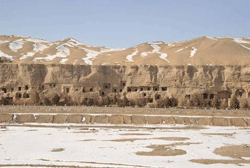New York, USA — This exhibit will present sculptures, scrolls, and other objects dating back more than a thousand years from the Dunhuang art shrine.
 An oasis city on the edge of the Gobi Desert, Dunhuang is home to the world’s most magnificent ancient Buddhist cave shrines, the Mogao Caves.
An oasis city on the edge of the Gobi Desert, Dunhuang is home to the world’s most magnificent ancient Buddhist cave shrines, the Mogao Caves.
For the first time in the U.S., an exhibition of rare treasures from the site will be on view at China Institute Gallery. Dunhuang: Buddhist Art at the Gateway of the Silk Road, on view from April 19 – July 21, 2013, will present a once-in-a-lifetime chance to see sculptures, scrolls, and other objects dating back more than a thousand years.
The exhibition kicks off a yearlong program at China Institute Gallery celebrating the arrival of treasures from the Mogao Caves, identified by UNESCO as a World Heritage Site in 1987. The Year of Dunhuang will include a second exhibition in the fall, as well as symposia, courses, lectures, and two exhibition catalogues.
The rich cultural history of Dunhuang is due in part to its location between Mongolia and Tibet on the Silk Road. A crucial hub for East-West trade, it was where “traditions of China and Western countries met, collided and merged,” as Fan Jinshi, Director, Dunhuang Academy, notes in the catalogue essay.
The western gateway to China, Dunhuang also boasts more than 800 caves, including the celebrated Mogao Caves, Yulin Caves, and Western Thousand Buddha Caves, carved into the cliffs.Dunhuang: Buddhist Art at the Gateway of the Silk Road will address art and ritual practices of the Northern dynasties (420-589) and the Tang dynasty (618-907). The exhibition will feature excavated art works, high relief clay figures, wooden sculptures, silk banners, and molded bricks.
A group of treasured Buddhist sutras from the famous Cangjingdong (The Hidden Library Cave) will illustrate the story behind Dunhuang’s historic discovery. A magnificent replica of the 8th century cave that houses the beautiful Bodhisattva of the Mogao Grottoes and an illustrious central pillar from the 6th century will also be prominently displayed to recall the actual cave setting.Among the highlights in Dunhuang: Buddhist Art at the Gateway of the Silk Road will be a group of treasured sutras from the famous Hidden Library Cave, as well as scrolls from the Northern, Tang, and Northern Song dynasties.
The Hidden Library Cave was discovered by a Daoist priest in 1900 while cleaning a cave next door. Sealed off since the 11th century, the cave contained one of the greatest treasure troves of ancient documents ever found. All in all, more than 50,000 objects, including cultural treasures such as Buddhist manuscripts, paintings, and religious objects, were discovered. This remarkable discovery introduced Dunhuang to the entire world. As Fan Jinshi, Director, Dunhuang Academy, writes in the catalogue essay, “His path-breaking discovery provided the world with a large number of study materials for the history, geography, religion, economics, politics, language, literature, art and science of China and Western Asia. These documents have been affectionately called the ‘Encyclopedia of the Middle Ages’ and the ‘ocean of ancient knowledge.’”
Dunhuang: Buddhist Art at the Gateway of the Silk Road will show some of the artists’ tools used to create the extraordinary frescoes that covered the walls, including paint mixing bowls and oil lamps to illuminate the dark caves. Not even the floors of the caves were ignored: Tang dynasty bricks molded with lotus flowers representing purity were used to pave the grounds in the caves.
About Fan Jinshi
Fan Jinshi, Director, Dunhuang Academy, is more widely known as the “daughter of Dunhuang.” She has spent more than four decades studying the history and preservation of the 1,600-year-old Dunhuang site. Under her leadership, state-of-the-art technology is being used to stabilize and preserve the caves and their treasures, including the establishment of a digital database.
About the International Dunhuang Project
The International Dunhuang Project (IDP) is an international collaborative effort to conserve, catalogue, and digitize manuscripts, printed texts, paintings, textiles, and artifacts from Dunhuang and the archaeological sites of the Eastern Silk Road. IDP plans to make them freely available on the Internet and encourage their use though educational and research programs. The project was established by the British Library in 1994 and now includes 22 institutions in 12 countries.
If you go
04/19/2013 – 07/21/2013 10:00AM – 5:00PM
China Institute Gallery
Address : 125 East 65th Street, New York, NY 10065
Phone : 212-744-8181
Website : www.chinainstitute.org
– Source : www.buddhistchannel.tv




